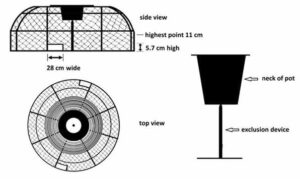Trap Excluder Device
WHAT ARE TRAP EXCLUDER DEVICES?
Excluder devices in pot and trap fisheries are technical adjustments made to the gear that prevent marine mammals from entering the pots or traps. Without these devices, seals and sea lions can enter the traps and either eat the catch (affecting the fisheries’ productivity) or get caught and drown.
A range of excluder devices have been suggested for use in the pot and trap fisheries. A simple modification of existing equipment, called the “spike” modification, and can be used for all types of pots and traps to help reduce bycatch. As seen in the diagram below, an upright steel rod is attached to the base of the pot, extending up towards the neck (or opening). This prevents large marine mammals from gaining full access to the pot, whilst showing no negative effect on catch rate/size of target species.
Other suggested modifications include a cross-bar positioned horizontally across the neck of the pot; deeper openings to the pots; use of stronger netting (to reduce equipment damage and possible entanglement) and smaller entrances to the pots (in line with target catch size).

Source: Mackay & Goldsworthy 2017
CURRENT RESEARCH & USE
Spike excluder devices are currently a legal requirement in Southern Australia’s Northern Zone Rock Lobster Fishery, following research demonstrating their success at mitigating sea lion bycatch. Development of other pot / trap excluder devices is ongoing in Australia, after industry raised concerns over the operational safety of the spike design.
This page was last updated on 10.12.24.
Interested in how this and other measures could mitigate bycatch in your fishery? Get in touch with us to collaborate or take part in a study.
